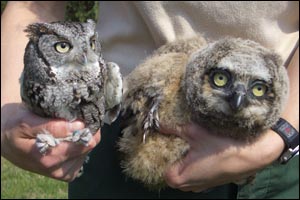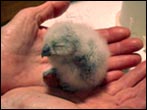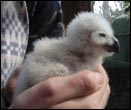 |
 |
 |
 |
 |
Adult
Typical Brown |
Adult Subarcticus |
Adult Red |
Subadult Dark |
Juvenile |
The Great Horned Owl is the second largest owl in North America, exceeded only by the Snowy (Nyctea scandiaca). Unlike this close relative though, there are many subspecies across the continent, each of which can be identified by specific colour variations. Indeed, this species can vary in colouration even within a small region, but the most dramatic differences are between birds from different latitudes. Lighter owls tend to exist predominently in northern areas, while darker birds inhabit more temperate regions. These differences are genetic and do not change between moults (with the exception of pigment loss in older birds). Great Horned Owls can range from nearly white (see above), to nearly black, to variations of brown and red (also above).
Like most owls, this species has a dense layer of feathering on its toes. This may seem counterproductive in hot areas, but it actually protects feet from bites received by prey. Great Horned Owls are one of few predators that will hunt skunk.
The Owl Foundation maintains several Great Horned Owl pairs as foster parents for orphaned young. We routinely receive 10 - 20 nestlings and fledglings each spring that we must quickly place with adult birds to achieve proper imprinting. A Great Horned Owl raised properly (by other Great Horned Owls) can communicate and breed normally when released into the wild. One raised by humans can become dangerous if it is hungry or in breeding condition and will never mate with another owl.
We utilize the natural
instincts of the species to determine which adult(s) a particular babe
should be placed with. The male owl generally feeds fledged young (birds
that have left the nest) directly, while his mate remains at the nest
to tend the nestlings (owls that are too young to leave the nest). As
such, fledged young are placed with adult males or pairs who have fledgling
babes of their own. Nestlings are placed with females who have laid eggs
or have similarly aged babes in the nest. Correct placement is crucial
to the survival of any young owl.
Adult Screech Owls (Otus asio) are often confused as "baby" Great Horned Owls. There are a few differences to look for:
- Screech Owls have bone
coloured beaks. Great Horned Owls, even babies, will have black beaks.
- Consider what time of
year it is. If it is autumn, the bird is likely an adult bird of a small
species (such as a Screech Owl). Great Horned Owls generally begin breeding
in late winter or early spring. By autumn, hatch year birds look like
adults.
- Young Great Horned Owls
have fuzzy natal down all over their bodies. As they grow,
this is moulted and adult feathers begin to grow in. By the time a young
Great Horned Owl begins growing in its adult feathers, it is much much
larger than a Screech Owl. Owls do not grow significantly
once they have all of their adult feathers.
If you find a small owl with smooth grey, brown or reddish feathers, chances are you have encountered an adult bird of a small species. The Screech Owl is the most commonly misidentified owl in Ontario. An adult stands about 6 inches tall.
 |
| Side
by side it is easy to see the difference between an adult Eastern
Screech Owl and a nestling Great Horned Owl. Notice the soft natal
down feathers of the Horned Owl in contrast to the grey adult plumage
of the Screech. |
Below is another useful size comparison, this time between a one to two week old nestling Screech Owl and one to two week old nestling Great Horned Owl. Note how much larger the young Great Horned Owl is.
 |
 |
Screech
Owl |
Great
Horned Owl |
The Great Horned Owl is named for the long ear-tufts found on top of the head. These tufts are not ears as many people believe. In fact, they are a grouping of feathers (usually consisting of 10 or more bigger ones) used in communication and camouflage. Just as cats and dogs will use their ears to convey confidence, fear or excitement, so do Great Horned Owls. An owl's age cannot be gauged by the length of its ear tufts. Owls usually moult these feathers once a year and as a result tufts are often shorter (longer feathers moulted out) or longer (newly developing feathers under the skin are pushing older ones out) than their actual length. A better method for aging any light-eyed owl is to examine its eye colour. Older owls tend to have deeper eye colourations. Unfortunately, this requires some experience.
Vocalizations:
Great Horned Owls are
best known for their territorial hoot commonly used on television as a
universal owl call. Traditionally the mneumonic for this is "Are
you awake? Me too". This vocalization is most often heard in late
winter and early spring. Male and female birds both call and will often
hoot back and forth, presenting their large white throat patches. Male
calls tend to include fewer individual notes ("Who's awake? Me too")
than females who's vocalizations are closer to "Whooo is awake? Me-EEE
too." Males in breeding condition will coax females to a nest site
with a low, repetitive, grunt-like hooting. When annoyed, these owls will
also produce a quick series of repeating stacatto screams that resemble
the neigh of a horse.
Vocalizations |
||
|
|
||
| Listen
for the well known "Are you awake? Me too" call from three
males. |
||
Spring
Vocalizations |
||
|
|
||
| A selection from the above: this is the repetitive grunting used by males to attract females. | ||
Male
Coaxing |
||
| Often produced by juveniles, this seems to be an exclamation of dismay and annoyance. | ||
Whinny |
||
| |
||
| Cries produced by nestlings when hungry. | ||
| Ignoring the Chickadee that wanted some time in the spotlight, this is an adult male GHOW making a rare vocalization. | ||
Bark |
||
Contact
Us | Hours | Home
| Legal
© 2008 The Owl Foundation
Owl vocalizations recorded by Kara Kristjanson.
Unless otherwise stated, all photographs and sound files are the property of The Owl Foundation.
No images or sounds on this website are to be duplicated in any way without express written permission
from the party to which they belong.
If you are interested in receiving quality versions, please contact The Owl Foundation.
